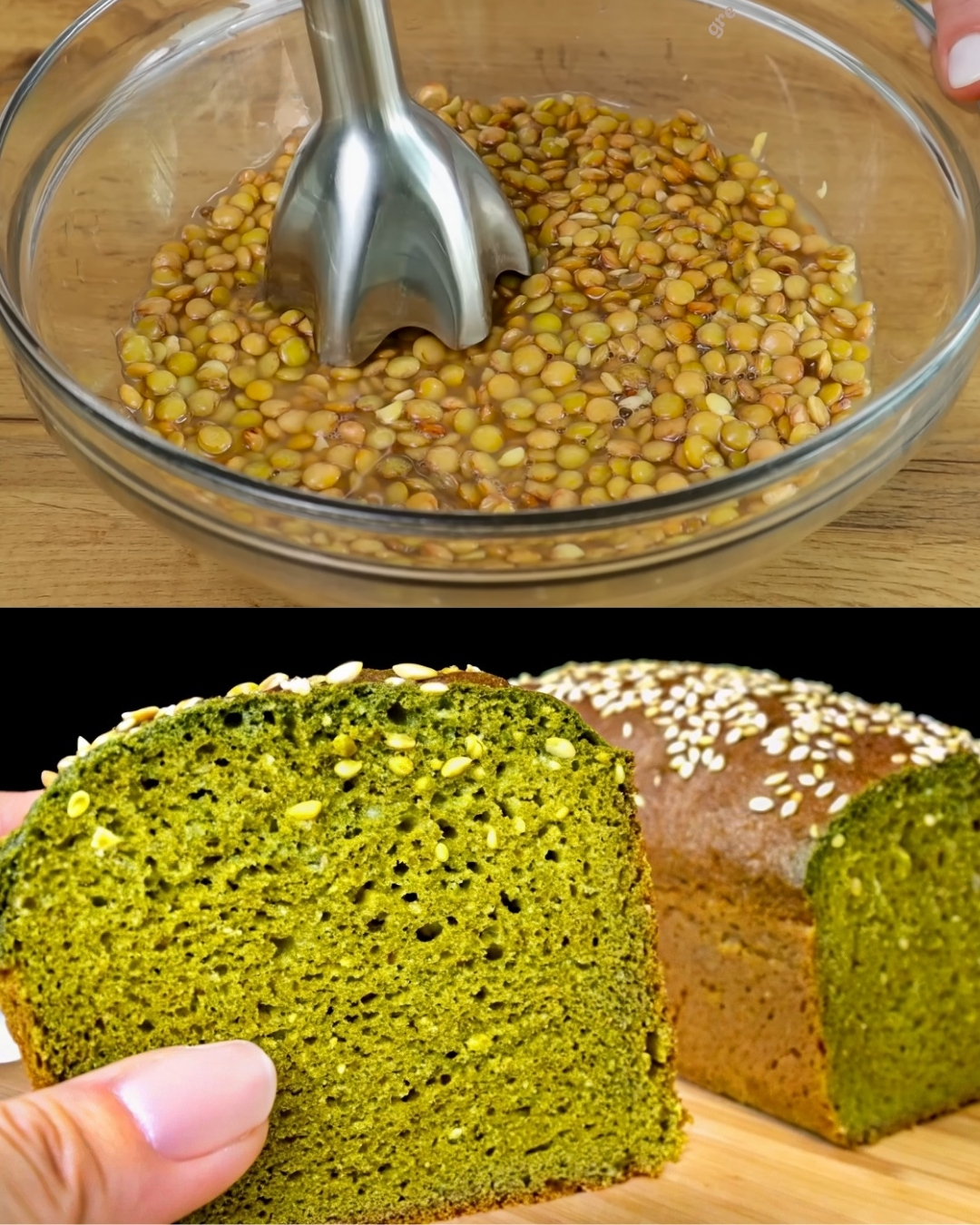If you’re looking for a gluten-free, protein-rich, and incredibly flavorful bread recipe, this Lentil Bread will impress you with both its taste and simplicity. Made from soaked lentils and enhanced with herbs, rice flour, and psyllium husk, this bread is a wholesome alternative to traditional loaves. Paired with a creamy vegetable sauce, this dish transforms into a complete meal that’s satisfying, nutrient-packed, and perfect for any time of the day.
Lentil bread has become a popular staple among those seeking healthier options, particularly in plant-based and gluten-free diets. With its soft interior, slightly nutty crust, and aromatic herb infusion, it’s as delicious as it is nourishing.
Cooking Time
-
Preparation Time: 10 minutes (excluding soaking time)
-
Soaking Time: 8 hours
-
Cooking Time: 50 minutes
-
Total Time: Approximately 9 hours
Ingredients
For the Lentil Bread:
-
250 g red lentils
-
500 ml water
-
30 ml olive oil
-
Fresh dill, chopped (as desired)
-
Fresh parsley, chopped (as desired)
-
Juice of half a lemon
-
2 tbsp rice flour
-
1 tsp turmeric
-
1 tsp salt (or to taste)
-
1 tsp ground coriander
-
1 tsp baking powder
-
2 tbsp psyllium husk
-
Olive oil (for greasing)
-
Sunflower seeds and sesame seeds for topping
For the Creamy Vegetable Sauce:
-
1 onion, finely chopped
-
1 carrot, grated or chopped
-
2 zucchinis, diced
-
2 garlic cloves, minced
-
Olive oil (for sautéing)
-
Salt and black pepper, to taste
-
Dill and parsley, finely chopped
-
1 small tub of cream cheese (approx. 100–150 g)
Step-by-Step Cooking Directions
Step 1: Soak the Lentils
Rinse 250 g of red lentils thoroughly under water. Place them in a bowl with 500 ml of water. Let them soak for 8 hours or overnight. This softens the lentils and helps improve their digestibility.
Step 2: Blend the Lentil Mixture
Once soaked, pour the lentils and remaining water into a blender. Add 30 ml of olive oil, fresh dill and parsley, and blend until smooth. This forms the base of your lentil bread dough.
Step 3: Mix Dry Ingredients
In a separate bowl, combine 2 tbsp rice flour, 1 tsp turmeric, 1 tsp ground coriander, 1 tsp salt, 1 tsp baking powder, and 2 tbsp psyllium husk. Mix well to evenly distribute the ingredients.
Step 4: Combine Everything
Add the dry mixture into the lentil puree. Squeeze in the juice of half a lemon and stir everything until fully combined. The dough should be thick but spreadable.
Step 5: Prepare for Baking
Grease a loaf pan with olive oil or line it with parchment paper. Pour the lentil mixture into the pan and smooth the top. Sprinkle with sunflower seeds and sesame seeds for a nutty, crunchy crust.
Step 6: Bake
Preheat your oven to 200°C (392°F). Bake the bread for 50 minutes or until golden and firm in the center. Let cool slightly before slicing.
Step 7: Prepare the Creamy Vegetable Sauce
While the bread is baking, prepare the sauce. In a skillet over medium heat, warm olive oil and sauté chopped onion for 2–3 minutes. Add the grated carrot and cook for another 3 minutes. Add diced zucchini, season with salt and black pepper, and sauté until tender (about 5–6 minutes).
Step 8: Add Garlic and Herbs
Stir in minced garlic, dill, and parsley. Cook for 1 minute more. Remove from heat and stir in cream cheese until the sauce becomes smooth and creamy. Adjust salt and pepper to taste.
Step 9: Serve
Slice the lentil bread and serve warm or room temperature, with generous spoonfuls of the creamy vegetable sauce on top or on the side. Enjoy!
Nutritional Information (Per Serving, Approximate)
-
Calories: 230
-
Protein: 10 g
-
Carbohydrates: 24 g
-
Fat: 9 g
-
Fiber: 7 g
-
Calcium: 8% DV
-
Iron: 12% DV
The Origins and Popularity of the Recipe
Lentil bread has its roots in modern gluten-free and vegan kitchens but takes inspiration from traditional Middle Eastern and Indian cuisine where lentils have been a dietary staple for centuries. In recent years, the simplicity and versatility of lentil-based baking have earned it a dedicated following across Europe, Australia, and health-focused communities in North America. It’s ideal for those seeking low-GI, dairy-free, and gluten-free options without sacrificing texture or flavor.
Reasons Why You’ll Love the Recipe
-
Nutrient-dense: Packed with protein, fiber, and minerals
-
Naturally gluten-free and vegan
-
Budget-friendly: Made with pantry staples
-
Meal-prep ready: Stays fresh for days and freezes well
-
Pairs well with spreads, soups, and dips
Health Benefits
-
Lentils provide protein, iron, and slow-digesting carbs
-
Psyllium husk supports digestion and gut health
-
Fresh herbs deliver antioxidants and boost flavor
-
Zucchini and carrots add vitamins A, C, and fiber
-
Cream cheese (optional) contributes calcium and richness
Serving Suggestions
-
Serve sliced with avocado or hummus for a hearty breakfast
-
Pair with soup or salad for a light lunch
-
Toast slices and top with cream cheese and herbs for a snack
-
Use as a gluten-free sandwich base
-
Spread with almond butter and honey for a sweet twist
Common Mistakes to Avoid
-
Not soaking lentils long enough: Leads to harder texture and uneven blending
-
Skipping psyllium husk: It binds the bread—vital for texture and structure
-
Too much water in the puree: Follow measurements closely
-
Overbaking: Can dry out the bread; check at 45 minutes
-
Under-seasoning: Lentils can be bland without enough spices and herbs
Pairing Recommendations
-
Soups: Tomato basil, pumpkin, lentil, or minestrone
-
Drinks: Herbal tea, fresh lemonade, or a glass of kefir
-
Dips: Hummus, baba ghanoush, tahini sauce, or herbed yogurt
-
Sides: Roasted chickpeas, tabbouleh, or cucumber salad
Cooking Tips
-
Use red lentils for the softest texture and fastest soaking
-
Blend in short bursts to avoid overheating the puree
-
Add a pinch of chili flakes for mild heat
-
If you don’t have psyllium husk, use chia seeds or ground flax as a binder
-
Let the bread cool slightly before slicing to avoid crumbling
Similar Recipes to Try
-
Chickpea flatbread
-
Vegan lentil patties
-
Gluten-free zucchini loaf
-
Savory oat bread
-
Red lentil pancakes (masoor cheela)
Variations to Try
-
Spicy version: Add chili powder or jalapeños
-
Cheesy version: Mix vegan or dairy cheese into the batter
-
Nutty version: Add walnuts or pumpkin seeds inside the dough
-
Sweet-savory twist: Add raisins and a touch of cinnamon
-
Mini muffins: Pour batter into muffin tins for snack-size bites
Ingredient Spotlight: Psyllium Husk
Psyllium husk is a powerful plant-based binder used in gluten-free baking. Derived from the seeds of Plantago ovata, it absorbs liquid and forms a gel, helping hold the dough together without gluten. In this lentil bread recipe, psyllium adds structure, elasticity, and improves the texture. It’s also rich in soluble fiber, which promotes digestive health and helps regulate blood sugar levels.
Conclusion
Lentil Bread with Creamy Vegetable Sauce proves that healthy, gluten-free eating doesn’t have to be boring. This recipe blends hearty legumes, fresh herbs, and creamy vegetables into a satisfying, flavorful experience. Perfect for meal prep, family dinners, or introducing more plant-based options into your diet, this bread is wholesome, easy to make, and endlessly adaptable. Once you try it, you’ll find yourself returning to this simple yet nourishing recipe again and again.
Frequently Asked Questions (FAQ)
1. Can I use green or brown lentils instead of red?
Red lentils are preferred for their soft texture and quick soaking, but green or brown can work if cooked longer and blended well.
2. What does psyllium husk do in this recipe?
It binds the bread, adds fiber, and creates a soft, flexible crumb without gluten.
3. Can I freeze the lentil bread?
Yes! Slice and store in an airtight container for up to 3 months. Reheat in the oven or toaster.
4. Is rice flour necessary?
It adds texture, but you can substitute it with oat flour, almond flour, or even cornmeal.
5. Can I make the bread without a blender?
You’ll need a blender or food processor to get a smooth batter. A hand blender works too.
6. Is this recipe vegan?
Yes, the bread and sauce can be fully vegan if you use plant-based cream cheese.
Advertisement
7. How long does the bread stay fresh?
It keeps in the fridge for up to 5 days. Toast lightly before serving.
8. Can I make this recipe oil-free?
Yes, but olive oil enhances moisture and richness. Consider using applesauce or yogurt as a substitute in small amounts.
9. What if I don’t have cream cheese for the sauce?
Use blended silken tofu or coconut cream as a creamy base alternative.
10. Can I turn this into muffins or smaller loaves?
Definitely! Just adjust the baking time to 25–30 minutes for smaller portions.

